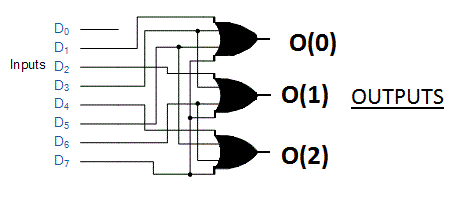Encoder (digital) on:
[Wikipedia]
[Google]
[Amazon]
 An encoder (or "simple encoder") in
An encoder (or "simple encoder") in  If the input circuit can guarantee at most a single-active input, a simple encoder is a better choice than a
If the input circuit can guarantee at most a single-active input, a simple encoder is a better choice than a


 An encoder (or "simple encoder") in
An encoder (or "simple encoder") in digital electronics
Digital electronics is a field of electronics involving the study of digital signals and the engineering of devices that use or produce them. This is in contrast to analog electronics and analog signals.
Digital electronic circuits are usual ...
is a one-hot to binary converter. That is, if there are 2''n'' input lines, and at most only one of them will ever be high, the binary code of this 'hot' line is produced on the ''n''-bit output lines. A binary encoder is the dual
Dual or Duals may refer to:
Paired/two things
* Dual (mathematics), a notion of paired concepts that mirror one another
** Dual (category theory), a formalization of mathematical duality
*** see more cases in :Duality theories
* Dual (grammatical ...
of a binary decoder
In digital electronics, a binary decoder is a combinational logic circuit that converts binary information from the n coded inputs to a maximum of 2n unique outputs. They are used in a wide variety of applications, including instruction decodin ...
.
For example, a 4-to-2 simple encoder takes 4 input bits and produces 2 output bits. The illustrated gate level example implements the simple encoder defined by the truth table, but it must be understood that for all the non-explicitly defined input combinations (i.e., inputs containing 0, 2, 3, or 4 high bits) the outputs are treated as don't cares.
priority encoder A priority encoder is a circuit or algorithm that compresses multiple binary inputs into a smaller number of outputs. The output of a priority encoder is the binary representation of the index of the most significant activated line, starting from z ...
, since it requires less logic to implement. However, a simple encoder can generate an incorrect output when more than a single input is active, so a priority encoder A priority encoder is a circuit or algorithm that compresses multiple binary inputs into a smaller number of outputs. The output of a priority encoder is the binary representation of the index of the most significant activated line, starting from z ...
is required in such cases.
Types of encoder
-to-n encoders
A -to-n encoder has n number of outputs in correspondence to the number of inputs. It thus reduces the number of transmission lines and can be compared to amultiplexer
In electronics, a multiplexer (or mux; spelled sometimes as multiplexor), also known as a data selector, is a device that selects between several analog or digital input signals and forwards the selected input to a single output line. The sel ...
. Only one of the inputs become "high" (logic state "1") at a time.
Some typical examples would be 4:2 encoder, 8:3 encoder, 16:4 encoders etc.
4-to-2 encoder

8-to-3 encoder

See also
*Binary decoder
In digital electronics, a binary decoder is a combinational logic circuit that converts binary information from the n coded inputs to a maximum of 2n unique outputs. They are used in a wide variety of applications, including instruction decodin ...
* Multiplexer
In electronics, a multiplexer (or mux; spelled sometimes as multiplexor), also known as a data selector, is a device that selects between several analog or digital input signals and forwards the selected input to a single output line. The sel ...
(MUX)
* Priority encoder A priority encoder is a circuit or algorithm that compresses multiple binary inputs into a smaller number of outputs. The output of a priority encoder is the binary representation of the index of the most significant activated line, starting from z ...
References
{{Reflist Digital electronics